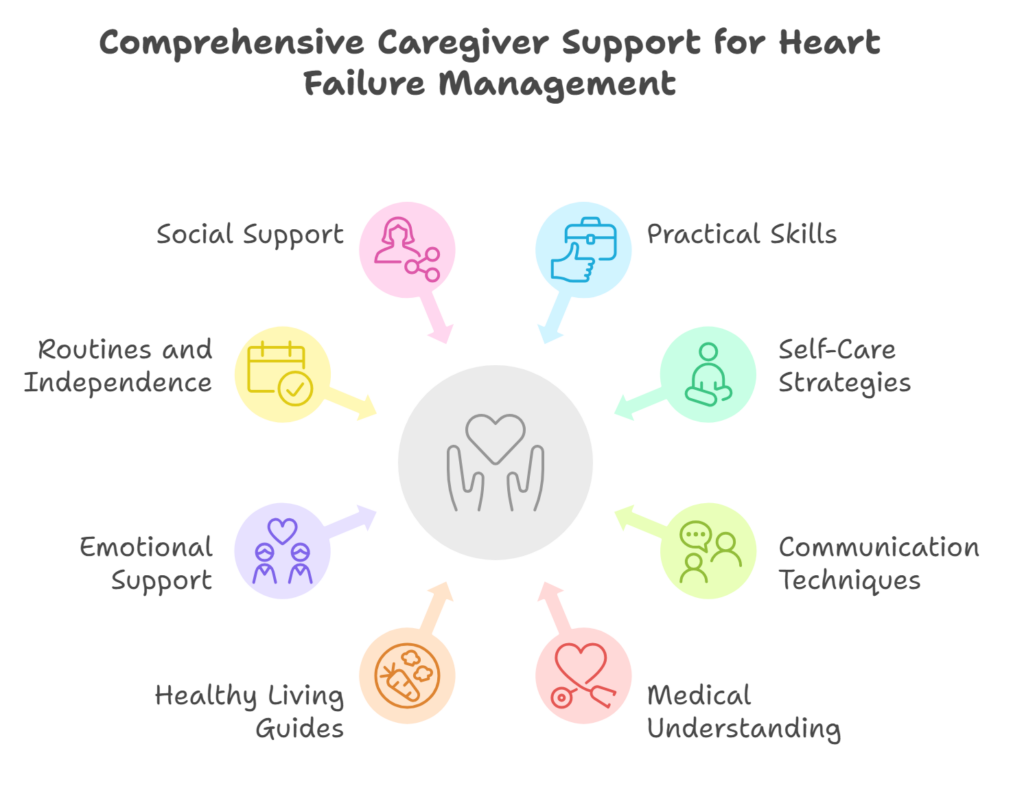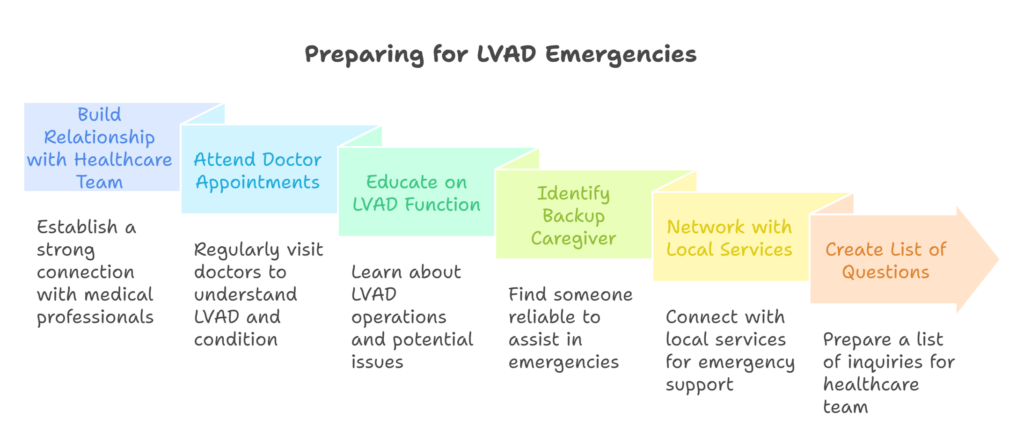Caring for a loved one with a Left Ventricular Assist Device (LVAD) can be both rewarding and challenging. At LVADStrong, we’re committed to supporting caregivers as they navigate this journey. Below are some of the most frequently asked questions by caretakers of LVAD patients – we encourage you to talk with your medical team including social workers to resolve any questions or challenges you may face.
1. What are the key areas of support and information available for LVAD caregivers?
Caregiver support resources focus on several vital areas. These include practical skills for daily care, self-care strategies for managing stress, effective communication techniques, and understanding the medical aspects of heart failure and LVAD management. Specifically, resources are available for managing the driveline site, medication schedules, recognizing signs of complications, understanding LVAD function, and developing problem-solving skills. There are also guides to healthy living such as nutrition and exercise, specifically tailored for those with heart conditions. Emotional and mental well-being support is also available through stress management tips, cognitive behavioral therapy exercises, mindfulness techniques, and caregiver support groups. Many resources also focus on establishing healthy routines, encouraging patient independence, and connecting with social support networks.

2. How can I, as a caregiver, effectively manage stress and avoid burnout?
Managing stress as an LVAD caregiver requires a multifaceted approach. It’s important to recognize the signs of caregiver stress, such as increased irritability, fatigue, and difficulty concentrating. Implement self-care practices like maintaining a balanced diet, getting regular physical activity, ensuring sufficient sleep, and attending to your own medical needs. Schedule time for hobbies and interests outside of caregiving. Practice techniques to manage emotions, like giving yourself quiet time or reading something uplifting when overwhelmed. Also, consider seeking support from counseling professionals who can help caregivers develop coping mechanisms. Importantly, don’t hesitate to ask for help from friends, family, or through caregiver support groups.
3. What specific changes can I expect in my life and the life of my loved one after an LVAD is implanted?
The implantation of an LVAD brings significant changes. Immediately following the procedure, your loved one will need substantial assistance with daily activities. Over time, the person may become more independent. However, ongoing help will still be necessary, such as cleaning the driveline site and managing medical appointments. You might also need to become familiar with the LVAD, how it works, and what to do in emergency situations, potentially involving your local energy company or first responders. Both the caregiver and the patient will need to adjust to new routines and lifestyles. Additionally, remember that emotions will likely fluctuate for both parties, with a mix of gratitude, stress, frustration, and possible resentment; you need to be prepared to navigate these feelings.
4. What steps can I take to prepare for potential complications or emergencies related to an LVAD?
Preparing for potential LVAD complications or emergencies involves several critical steps. First, build a strong relationship with your healthcare team and attend as many doctor appointments as possible to learn about the device and your loved one’s condition. Educate yourself about the specific function and potential issues with the LVAD. Identify a backup caregiver who can help when needed. Network and communicate with local services that may be essential in emergencies. Create a list of questions for your healthcare team about scenarios and potential issues that may arise. Finally, make sure you are trained in basic emergency care, specifically related to LVAD management, such as what to do during power outages or driveline alarms.

5. How important is it for caregivers to prioritize their own well-being?
Prioritizing your own well-being as a caregiver is crucial, not optional. Caregivers are better able to provide good care when they are themselves healthy, both physically and emotionally. Ignoring your own needs can lead to burnout, which impacts not just you, but the person you are caring for. Remember you are not alone, and seek assistance to relieve the burden. Taking time for yourself, pursuing hobbies, maintaining social connections, and seeking support when needed are all important components of good self-care. Prioritizing your well-being is not selfish; it is an essential component of your caregiving role.
6. What strategies can I use to enhance communication and collaboration with my loved one who has an LVAD?
Effective communication and collaboration are key to successful caregiving. Being a good listener to your loved one’s needs is extremely important. Encourage open discussions about their condition, symptoms, and treatment. Work together with your loved one to set goals for their recovery. Recognize that mood and behavior may not always reflect feelings towards the caregiver, and that many factors including pain, discomfort, or medication side effects can impact this. Also, make sure to ask about their understanding of the information they have been provided. Be empathetic and provide support when needed.
7. How can I encourage the person I care for to be more independent, and why is this important?
Encouraging independence can be beneficial for both the caregiver and the person with an LVAD. As your loved one recovers, identify tasks and activities they can safely manage on their own. This can help to restore their sense of control and autonomy. Initially you may need to support them with this process. This not only boosts your loved one’s self-esteem but also frees up the caregiver to attend to their own responsibilities and needs. This can lead to a healthier dynamic for the caregiver.
8. What types of resources are available for connecting with other LVAD caregivers and finding support?
Many resources exist for LVAD caregivers to connect and find support. Online forums and discussion boards, like those on MyLVAD.com, can connect you with other caregivers to share questions, stories, and advice. Local and national support groups can provide peer support and help with understanding the emotional challenges of caregiving. Additionally, websites from organizations like the Caregiver Action Network, Caregiver.com, and AARP offer educational materials and resources specifically designed for caregivers. These communities can help you know you’re not alone and offer a safe space to discuss your experiences.
We’re Here to Help
The journey of caring for someone with an LVAD is unique, and you don’t have to face it alone. At LVADStrong, we offer ongoing support and resources to help you provide the best care possible. If you have questions or need additional assistance, don’t hesitate to reach out.
Contact us today to learn more about how we can support you and your loved one through this journey.
